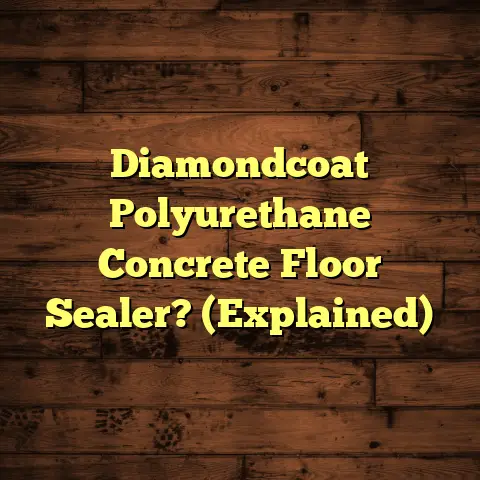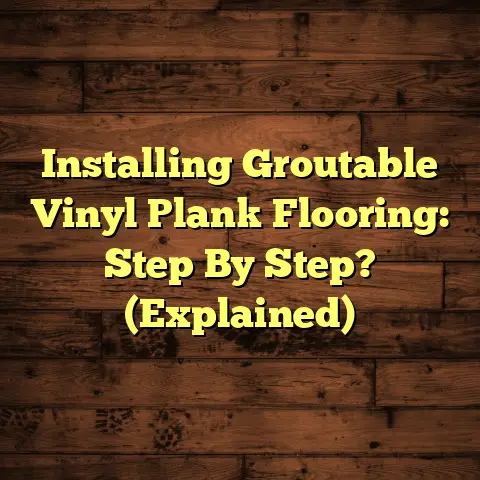Filling Large Holes In Concrete? (2 Options Now!)
In the wild world of home improvement, there’s a funny contradiction when it comes to concrete.
On one hand, we brag about how tough it is, a real champion against time and whatever Mother Nature throws at it.
But then BAM! Cracks, chips, and holes appear, like unwelcome guests at a party. It makes you wonder: how can something so strong need so much TLC?
Well, that’s the puzzle we’re cracking today! I’m going to walk you through filling those pesky large holes in concrete, showing you two solid ways to bring your surfaces back to life.
Let’s get started, shall we?
Section 1: Understanding Large Holes in Concrete
1.1 The Causes of Large Holes
Ever wonder how those gaping holes appear in your seemingly indestructible concrete?
I’ve seen it all in my years as a flooring contractor.
-
Weather’s Wrath: Freeze-thaw cycles are a major culprit. Water seeps into tiny cracks, freezes, expands, and voila! The concrete weakens. I’ve seen entire driveways crumble because of this! According to the Portland Cement Association, proper sealing can significantly reduce this damage. https://www.cement.org/
-
Heavy Loads: Think about it. Driveways bear the weight of cars, garages hold tools and equipment, and patios see heavy foot traffic. All that pressure can eventually take its toll, especially if the concrete wasn’t properly reinforced to begin with.
-
Installation Fails: This is a big one. If the concrete wasn’t mixed correctly, poured properly, or cured right, it’s going to be weaker from the get-go. I always tell people, “You get what you pay for.” Skimping on the installation can lead to major headaches later.
-
Moisture Mayhem: Water is sneaky. It can find its way into the tiniest cracks and, over time, erode the concrete from the inside out. Poor drainage is a common cause of this.
1.2 The Impact of Large Holes
Okay, so you’ve got a hole. Big deal, right? Wrong! Ignoring those holes can lead to some serious problems down the road.
-
Safety First (Always!): A big hole is a tripping hazard, plain and simple. I’ve seen people twist ankles and even fall because of these things. Especially if you have kids or elderly folks around, it’s a real risk.
-
Structural Nightmare: Water can get into the hole, freeze, and expand, causing even more damage to the surrounding concrete. It’s like a domino effect. What starts as a small problem can quickly become a structural disaster.
-
Curb Appeal Killer: Let’s face it, a big ugly hole in your driveway or patio is not a good look. It can bring down the entire aesthetic of your property.
-
Wallet Woes: The longer you wait to fix it, the worse it gets. And the worse it gets, the more it’s going to cost you in the long run. Trust me, a small repair now is way cheaper than a major overhaul later.
So, are we convinced that fixing those holes is important? Good! Let’s move on to the repair process.
Section 2: Preparing for the Repair Process
2.1 Assessing the Damage
Alright, before you grab your tools and dive in headfirst, let’s take a good look at the damage.
-
Size Matters: How big is the hole? Is it a small pothole or a crater? This will determine how much filler you need and the best approach to take.
-
Depth Perception: How deep does the hole go? Is it just a surface issue or does it go all the way through? Deeper holes may require multiple layers of filler.
-
Surrounding Scene: How’s the concrete around the hole? Is it cracked, crumbly, or solid? If the surrounding concrete is weak, you may need to remove some of it to create a stable base for your repair.
Tools of the Trade:
Here’s a list of tools you’ll likely need:
- Safety Glasses: Protect those peepers!
- Gloves: Keep your hands clean and safe.
- Chisel and Hammer: For removing loose concrete.
- Wire Brush: For scrubbing and cleaning.
- Shop Vac: For sucking up dust and debris.
- Trowel: For applying and smoothing the filler.
- Mixing Bucket: For mixing the filler.
- Water: For mixing the filler and cleaning.
- Measuring Tools: For accurate mixing ratios.
2.2 Cleaning the Area
This is crucial. You can’t just slap some filler into a dirty hole and expect it to hold. The filler needs a clean, solid surface to bond to.
Step-by-Step Cleaning Guide:
-
Clear the Decks: Remove any loose concrete, rocks, dirt, or debris from the hole and the surrounding area. The chisel and hammer are your friends here.
-
Scrub-a-Dub-Dub: Use the wire brush to scrub away any remaining dirt, dust, or loose particles. Get in there and really work it!
-
Vacuum Time: Use the shop vac to suck up all the dust and debris. You want a completely clean surface.
-
Rinse and Repeat (Maybe): If the hole is particularly dirty, you can rinse it with water and let it dry completely before moving on.
Pro Tip: A clean surface is a happy surface! The better you clean the area, the stronger and longer-lasting your repair will be.
Section 3: Option 1: Using Epoxy Fillers
3.1 What Are Epoxy Fillers?
Alright, let’s talk about epoxy fillers. These are basically super-strong adhesives that are perfect for repairing concrete.
-
The Chemistry Lesson (Simplified): Epoxy fillers are made up of two parts: a resin and a hardener. When you mix them together, a chemical reaction occurs that creates a super-strong, durable material.
-
Why Epoxy Rocks: Epoxy fillers are known for their strength, durability, and resistance to moisture. They can withstand heavy loads and extreme temperatures, making them ideal for outdoor repairs.
-
Versatility is Key: Epoxy fillers can be used to repair a wide range of concrete damage, from small cracks to large holes. They can also be tinted to match the color of your existing concrete.
3.2 Step-by-Step Guide to Using Epoxy Fillers
Okay, let’s get our hands dirty! Here’s a step-by-step guide to using epoxy fillers:
-
Gear Up: Put on your safety glasses and gloves. Epoxy can be irritating to the skin and eyes.
-
Mix It Up: Carefully measure out the resin and hardener according to the manufacturer’s instructions. This is crucial. Too much or too little of either component can weaken the epoxy. Use a clean mixing bucket and a stir stick.
-
Stir, Don’t Shake: Mix the resin and hardener thoroughly for the recommended amount of time. Be sure to scrape the sides and bottom of the bucket to ensure everything is fully mixed.
-
Apply with Confidence: Use the trowel to apply the epoxy filler to the hole. Press it firmly into the hole to ensure good adhesion.
-
Level Up: Use the trowel to smooth out the surface of the epoxy filler, making it flush with the surrounding concrete.
-
Patience is a Virtue: Allow the epoxy filler to cure completely according to the manufacturer’s instructions. This can take anywhere from a few hours to a few days, depending on the product and the temperature.
-
Smooth Operator (Optional): Once the epoxy is fully cured, you can sand it down to create an even smoother finish.
Safety First!
- Always work in a well-ventilated area.
- Avoid contact with skin and eyes.
- Wear safety glasses and gloves.
- Follow the manufacturer’s instructions carefully.
3.3 Considerations for Epoxy Fillers
Epoxy fillers are great, but they’re not perfect for every situation.
-
Temperature Tango: Epoxy fillers work best in moderate temperatures. Extreme heat or cold can affect the curing time and the strength of the epoxy.
-
Humidity Hurdles: High humidity can also affect the curing process. It’s best to apply epoxy on a dry day.
-
Mixing Matters: Precise mixing is essential. If you don’t mix the resin and hardener correctly, the epoxy won’t cure properly and it will be weak and brittle.
-
Curing Conundrum: The curing time can be a bit of a pain, especially if you’re in a hurry. You’ll need to keep people and pets away from the area while the epoxy is curing.
Section 4: Option 2: Using Concrete Patch Mix
4.1 What Is Concrete Patch Mix?
Now, let’s talk about concrete patch mix. This is a more traditional option for repairing concrete.
-
The Classic Choice: Concrete patch mix is basically a blend of cement, sand, and other aggregates. When you add water, it creates a mortar-like substance that can be used to fill holes and cracks in concrete.
-
Easy Does It: Concrete patch mix is generally easier to use than epoxy fillers. It’s also more readily available and often less expensive.
-
The Go-To for Big Jobs: Concrete patch mix is a good choice for larger repairs where strength isn’t as critical as ease of use and cost-effectiveness.
4.2 Step-by-Step Guide to Using Concrete Patch Mix
Here’s how to use concrete patch mix:
-
Prep Like a Pro: Clean the hole and surrounding area as described in Section
- This is still essential!
-
Wet the Spot: Dampen the inside of the hole with water. This helps the patch mix bond to the existing concrete.
-
Mix It Up (Again!): Add water to the concrete patch mix according to the manufacturer’s instructions. Mix until you have a smooth, workable consistency.
-
Layer It On: Use the trowel to apply the patch mix to the hole. For deeper holes, apply the patch mix in layers, allowing each layer to dry slightly before adding the next.
-
Smooth Sailing: Use the trowel to smooth out the surface of the patch mix, making it flush with the surrounding concrete.
-
Cure and Protect: Keep the patched area damp for several days to allow the concrete to cure properly. You can cover it with plastic or spray it with water periodically.
4.3 Considerations for Concrete Patch Mix
Concrete patch mix is a great option, but here are a few things to keep in mind:
-
Surface Savvy: Concrete patch mix is best suited for horizontal surfaces like driveways, patios, and sidewalks. It’s not as well-suited for vertical surfaces.
-
Weather Watch: Avoid applying concrete patch mix in extreme temperatures or wet weather.
-
Shrinkage Shenanigans: Concrete patch mix can shrink as it dries, which can lead to cracks. Applying it in layers can help minimize shrinkage.
-
Color Coordination: Concrete patch mix may not perfectly match the color of your existing concrete. You can try to find a patch mix that’s close in color, or you can apply a concrete stain to blend it in.
Section 5: Comparing the Two Options
Alright, we’ve covered both epoxy fillers and concrete patch mix. Now, let’s compare them side-by-side:
5.1 Strength and Durability
-
Epoxy Fillers: Epoxy fillers are the clear winner in terms of strength and durability. They can withstand heavier loads, extreme temperatures, and constant moisture.
-
Concrete Patch Mix: Concrete patch mix is still strong, but not as strong as epoxy. It’s more susceptible to cracking and damage from freeze-thaw cycles.
5.2 Cost and Accessibility
-
Epoxy Fillers: Epoxy fillers are generally more expensive than concrete patch mix. They may also be harder to find in some local hardware stores.
-
Concrete Patch Mix: Concrete patch mix is readily available at most hardware stores and is generally more budget-friendly.
5.3 Ease of Use
-
Epoxy Fillers: Epoxy fillers require more precise mixing and application. The curing time can also be a bit of a pain.
-
Concrete Patch Mix: Concrete patch mix is easier to mix and apply. It’s a good choice for DIYers who are new to concrete repair.
The Verdict:
So, which option is right for you?
-
Choose Epoxy Fillers If: You need maximum strength and durability, and you’re willing to spend a bit more money and time.
-
Choose Concrete Patch Mix If: You’re on a budget, you need to repair a large area, and you’re comfortable with a slightly less durable repair.
Section 6: Final Thoughts on Repairing Large Holes in Concrete
6.1 Recap of Key Points
Alright, let’s recap what we’ve learned:
-
Large holes in concrete can be caused by weather, heavy loads, and improper installation.
-
Ignoring these holes can lead to safety hazards, structural damage, and aesthetic problems.
-
Preparing the area properly is crucial for a successful repair.
-
Epoxy fillers are strong and durable, but more expensive and require more precise application.
-
Concrete patch mix is easier to use and more budget-friendly, but not as strong as epoxy.
6.2 Encouragement for DIY Enthusiasts
I know repairing concrete can seem daunting, but it’s totally doable! With the right tools, materials, and a little bit of patience, you can tackle those holes and bring your concrete surfaces back to life.
Don’t be afraid to give it a try! And if you ever get stuck, don’t hesitate to call a professional. We’re always here to help.
Happy repairing!





